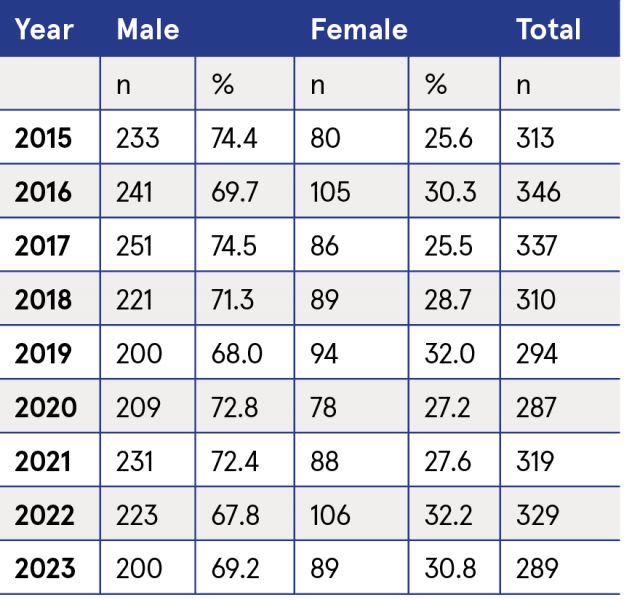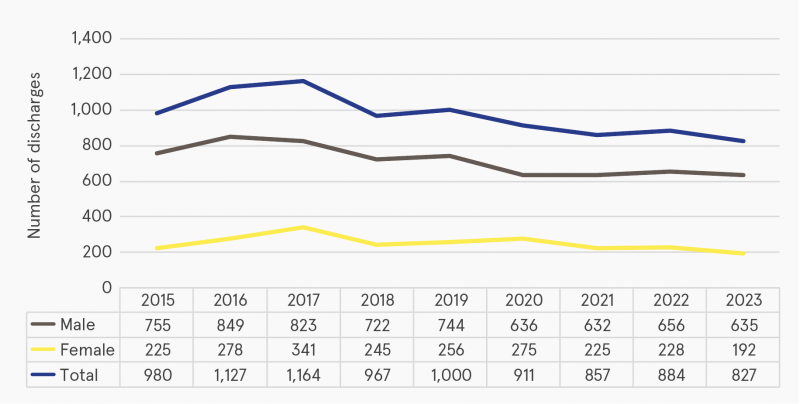Doyle, Anne  ORCID: https://orcid.org/0000-0002-2776-3476
(2025)
Alcohol-related brain injury hospitalisations, 2015–2023.
Drugnet Ireland,
Issue 90, Winter 2025,
pp. 12-14.
ORCID: https://orcid.org/0000-0002-2776-3476
(2025)
Alcohol-related brain injury hospitalisations, 2015–2023.
Drugnet Ireland,
Issue 90, Winter 2025,
pp. 12-14.
| Preview | Title | Contact |
|---|---|---|
|
PDF (Drugnet Ireland issue 90)
1MB |
Background
Alcohol-related brain injury (ARBI) is a term that encompasses various conditions associated with heavy and prolonged alcohol use.1-3 Wernicke encephalopathy and Korsakoff syndrome are the two most commonly known conditions, and develop as a result of thiamine deficiency (vitamin B1).4 Most at risk are those with alcohol dependency who may substitute food with alcohol. Their poor diet, and particularly the lack of vitamin B1, as well as alcohol interfering with the absorption and metabolism of vitamin B1, increase the risk of developing thiamine deficiency, and consequently ARBI.
Symptoms of ARBI include a cognitive impairment and behavioural changes, including short-term memory loss, an inability of the brain to shift focus from one task or idea to another, limited attention span or ability to focus, difficulty regulating self-control (both behaviourally and emotionally), difficulty with decision-making, and diminished social interaction.
This article aims to calculate the number of hospitalisations due to ARBI in Ireland from
2015 to 2023.
Methods
Data on ARBI hospitalisations were obtained from the Hospital In-Patient Enquiry (HIPE) scheme.5 HIPE is a computerised health information system designed to collect demographic, medical, and administrative data on admissions, discharges, and deaths from acute general hospitals in Ireland. The system is managed by the Healthcare Pricing Office (HPO) in the Health Service Executive (HSE).
The use of HIPE data for epidemiological purposes has some limitations. Each HIPE discharge record represents one episode of care; patients may be admitted to hospital(s) more than once with the same or different diagnoses. Emergency department (ED) and outpatient data are not collected. The HIPE system records the number of inpatient events rather than the number of patients and, as these records do not carry an individual health identifier, it is not possible to ascertain the incidence of alcohol-related brain morbidity.
The data presented here relate to the period 2015–2023, based on the International Statistical Classification of Diseases and Related Health Problems, Tenth Revision, Australian Modification (ICD-10-AM).6
Results
Table 1 provides the annual number of ARBI hospitalisations between 2015 and 2023. These are the hospitalisations where one or more of the ICD-10-AM codes* were listed as the primary diagnosis or as any one of the up to 29 additional diagnoses listed on the HIPE discharge record.
Hospital discharge data indicate that there was a mean of 314 ARBI hospitalisations annually, with the highest number recorded in 2016 (n=346). Such hospitalisations were more than twice as common among males as among females.
Table 1: Number of discharges reported to HIPE from acute hospitals with an ARBI diagnosis code (ICD-10-AM codes F10.6, F10.7, G31.2), by year and sex, 2015–2023

As ARBI is difficult to diagnose, the data presented in Table 1 are likely an under-representation of ARBI hospitalisations. In order to examine brain injury hospitalisations that may also be related to alcohol use, data from HIPE were analysed where a brain injury diagnosis† and alcohol-related condition‡ were both included on the HIPE discharge record.
Figure 1 provides an annual breakdown of the hospital discharges where a brain injury diagnosis and an alcohol-related condition were included as two separate diagnoses on the HIPE discharge record. It is not possible to determine whether the two diagnoses were related. However, given the limited information available elsewhere, this may be used as a proxy to understand the prevalence of such hospitalisations.

Figure 1: Number of discharges reported to HIPE from acute hospitals with a brain injury diagnosis code and an alcohol-related diagnosis code, by year and sex, 2015–2023
The mean number of annual hospital discharges where both an alcohol-related condition and a brain injury condition were recorded on the HIPE record was 969 during the period 2015–2023. During this period, the mean number of annual hospital discharges for males was 717, while the corresponding figure for females was 252. The greatest number of discharges was recorded in 2017 (n=1164). A decline in the number of discharges related to such a combination of conditions is evident in the period 2015–2023, when it decreased by 15.6%.
Conclusion
There is limited information about ARBI prevalence in Ireland, and due to the complexity in diagnosing and under-reporting, the data from HIPE can be used as a guide to understanding the potential number of hospitalisations of those with a suspected ARBI.
1 Alcohol Forum Ireland (nd) Alcohol-related brain injury. Alcohol Forum Ireland. Available from:
https://www.drugsandalcohol.ie/38326/ (accessed 20 Dec 2024).
2 McMonagle H (2015) Alcohol-related brain injury: a guide for families. Letterkenny: Alcohol Forum. Available from: https://www.drugsandalcohol.ie/23831/
3 Neurological Alliance of Ireland (2021) Meeting the needs of people with Korsakoff’s Syndrome in Ireland: Identifying treatment pathways and specialist services. Dublin, Neurological Alliance of Ireland. Available from: https://www.drugsandalcohol.ie/42801/ (accessed 13 Jan 2025).
4 McMonagle H, Hogan M, Morrissey AM, et al. (2015) Alcohol-related brain injury: a guide for professionals. Letterkenny: Alcohol Forum. Available from: https://www.drugsandalcohol.ie/23832/
5 Healthcare Pricing Office (nd) Hospital Inpatient Enquiry (HIPE) scheme. Available from:
https://www.hpo.ie/ (accessed 20 Dec 2024).
6 National Centre for Classification in Health (Australia) (2017) The International Statistical Classification of Diseases and Related Health Problems, 10th Revision, Australian Modification (ICD-10-AM). National Centre for Classification in Health. Available from: https://www.ihacpa.gov.au/resources/icd-10-amachiacs-tenth-edition
B Substances > Alcohol
E Concepts in biomedical areas > Nervous system physiology (brain, neural)
G Health and disease > Substance use disorder (addiction) > Alcohol use disorder
G Health and disease > Neurological condition / disease (nervous system, brain)
J Health care, prevention, harm reduction and treatment > Patient / client care management
J Health care, prevention, harm reduction and treatment > Health care programme, service or facility > Hospital
VA Geographic area > Europe > Ireland
Repository Staff Only: item control page